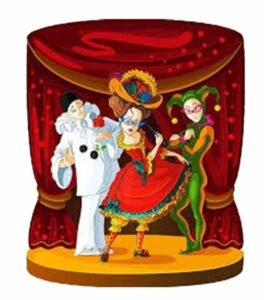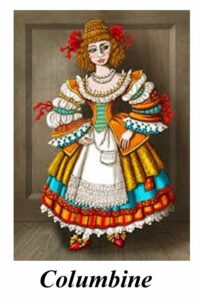In the History of Pantomime, it is claimed that Pantomime has its roots in ‘Commedia dell’Arte’, a 16th-century Italian entertainment, however, in Roman in 467 BC they had Pantomimus , which was a mime show with a single dancer, it was popular especially with the Roman Emperors. It is has been claimed that Emperor Nero, was so jealous of his own pantomime performer he had him put to death for being so talented!
We don’t know if this is true or just hearsay, but it is a good story.
When we reach the middle ages, we find that the medieval mystery plays always had the ‘goodies’ entering from stage right and the ‘baddies’ from stage left. Was this a form of pantomime?
In fact, we still have this tradition of the goodies coming on from the right and the baddies the left. Isn’t it amazing that it is actually a 600 year old tradition!
 However, the ‘Commedia dell’Arte’ was similar to what we have today, it had dance, music, tumbling, acrobatics and a cast of mischievous stock characters headed by the Harlequin.
However, the ‘Commedia dell’Arte’ was similar to what we have today, it had dance, music, tumbling, acrobatics and a cast of mischievous stock characters headed by the Harlequin.
Now the Harlequin is an interesting character. He was the light-hearted, nimble, and servant, who was always finding ways to frustrate his master’s plans, so everyone knew who e was when he came on stage by his chequered costume.
He interesting thing about these days was that women couldn’t to be part of the story, but they could dance between scenes. Inevitably they came on stage, to start with as bosomy and gossipy servants but soon as characters. Normally, very down to earth personalities that always saw the situation for what it actually was.
They were always on stage in a short ragged and patched dress with too much makeup.
 The most famous girl in ‘Commedia dell’Arte’ was called Columbine aid. She is sometimes the lover of Harlequin, but not always. They sometimes engage in sexual activity, but not always. She was usually a flirtatious and impudent character with wit and resourcefulness, often competing with the sterner and melancholic Pierrot.
The most famous girl in ‘Commedia dell’Arte’ was called Columbine aid. She is sometimes the lover of Harlequin, but not always. They sometimes engage in sexual activity, but not always. She was usually a flirtatious and impudent character with wit and resourcefulness, often competing with the sterner and melancholic Pierrot.
These first pantomimes appeared in different forms in the late 1600s onwards. They were comedies with simple plot that was got across through slapstick and dance, rather than words.
Basically, they were nothing like today’s pantomime but they started a theatrical tradition that over the years has become our Pantomime.
Cheesy songs, good triumphing over evil and a good laugh this is Pantomime.
Now our sister site Educationalmusicals.co.uk would like to make this tradition even easier so that it can be performed by more of our schools, drama groups and even youth clubs.
We have published five “Potty Pantos” that are potted because they are only between 30 to 40 minutes long, and are “potty” as they have taken the traditional panto stories and given them a “potty” switch.
With the result that you have
- Aladdin’s Lump, a lump of old metal.
- Jack and His Big Stork, a big bird.
- Goldilocks and the Three Scares, monsters who like living in a mess.
- Daring Dick, who is a rich not poor boy.
- Snow White and the Magnificent Seven, where she meets some unusual cowboys.
The writer, Anthony James, says:
“I have written these Potty Pantos so that any group can produce a short, simple and fun pantomime, the jokes are corny and the songs great fun. They really are great little stand alone shows achievable by anyone. We have even included a simple art pack so that even the smallest group can make the scenery, costumes and props from recycled materials resulting in a scenic spectacle for everyone to watch.”

To learn more and listen to two of the songs from each show go to Potty Pantos.
“OH NOW DON’T …OH YES YOU DO’
Panto is fun!
10 Questions to discuss:
- Before ‘Commedia’: Is there any evidence of theatrical or entertainment forms resembling pantomime existing before “Commedia dell’Arte” in the 16th century?
- Roman Mimes: Despite the earlier “Pantomimus,” how do historians distinguish it from the later pantomime tradition known today?
- Medieval Mystery Plays: What factors suggest a potential connection between these plays and modern pantomime beyond the good/bad side entrances?
- Harlequin’s Evolution: How did the Harlequin character and his iconic costume change or adapt over time in pantomime?
- Gender Roles: What social or cultural factors led to the initial exclusion of women in acting for “Commedia dell’Arte” and their subsequent integration?
- Columbine: Describe how Columbine’s portrayal and relationship with Harlequin varied in different eras of pantomime.
- Early Pantomimes: What were some specific examples of these early non-verbal pantomimes in the late 1600s, and what themes did they typically explore?
- Transformation over Time: What were the biggest changes or developments that shaped pantomime into its modern form with songs, humor, and clear narratives?
- Global Influences: Did any cultures or theatrical traditions outside of Europe contribute to the evolution of pantomime?
- Future of Pantomime: With evolving audience preferences and entertainment options, how do you think pantomime can continue to remain relevant and popular?
These are just some suggestions, and you can choose the ones that pique your curiosity the most for further exploration!
For more on pantomime history:
© Tony Dalton

